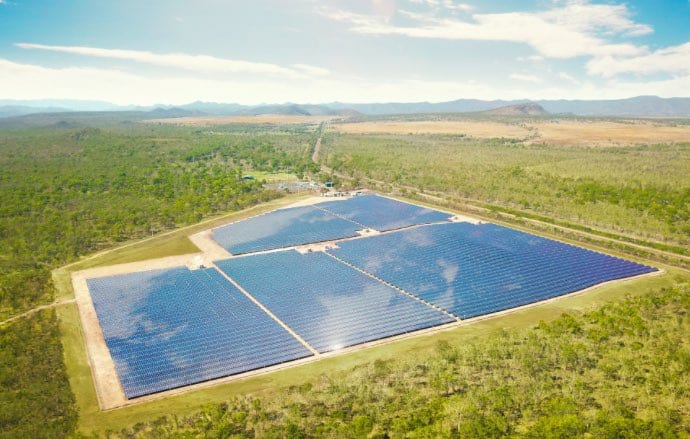Lyon Group and Japanese energy company Jera say they plan to begin construction of a large solar plus battery storage project in north Queensland in early 2019, after reaching agreement on the project’s generator performance standard with the Australian Energy Market Operator this week.
The Cape York solar and battery project, near the smaller but existing Lakeland solar and storage installation (pictured above), will feature a 55MW solar farm and a 20MW/80MWh battery built by Fluence, which has also delivered the Ballarat battery in Victoria and will build the 10MW/10MWh battery next to the Lincoln Gap wind farm in South Australia.
In a statement, Lyon Group described the $150 million facility as a “world first Queensland dispatchable solar peaker”, that operates through a a single connection point.
This means, the company says, that it can operate as a “semi-scheduled” solar generator with up to 55MW of capacity, but also deliver 20MW of fully scheduled capacity through the battery, when the conditions (and the prices) suit.
An announcement of reaching a GPS agreement is highly unusual, but possibly cause for celebration due to the unique nature of this project. A company spokesman said an off-take agreement is still being finalised, but finance is in place.
Lyon Group has talked much of its various solar and battery storage project ambitions, particularly some large projects in South Australia and Victoria that have yet to see the light of day, and it has been involved in a court dispute with First Solar over payments for one of those projects.
Last year, however, Lyon signed a joint venture with Jera, a huge and deep-pocketed Japanese energy company with some 74GW of generation in its portfolio, and Fluence, a joint venture between Siemens and AES, to advance the Cape York and other projects. Jera itself is an equal joint venture of two major Japanese electricity companies, Tepco and Chubu Electric Power Co.
“The Cape York Battery Power Plant will be the first fully integrated grid-connected large dispatchable solar peaker in Australia if not the world,” Lyon CEO David Green said in a statement.
“The 20MW/80MWh Fluence battery-based energy storage system plus 55MWac solar generation will dispatch firm clean energy through a single connection point, using a single power plant controller.”
Green said only a “truly integrated” battery and solar plant could avoid grid destabilising voltage and frequency fluctuations, and transitory impacts.
“Projects like this can reduce grid costs by lifting transmission utilisation, so that network augmentation can be deferred, reduced or in some cases avoided,” he said.
“Weather-dependent renewable energy still has a future in Australia, but dispatchable renewables are far more valuable, and regulatory reforms will lift revenues for high-speed, flexible services.”
The battery storage industry has lamented the fact that rules and regulations applying to the grid have failed to keep pace with technology – not recognising their speed and accuracy and flexibility, and making it difficult to combine both wind and solar storage into one facility.
Some key changes, such as a switch to 5-minute settlement periods, will not take place until 2021. AEMO is looking at rules to make it easier for wind and solar and storage projects to be combined.
Green says that solar peaking plants will quickly take the place of gas peakers because their speed of dispatch, lower and more predictable operating costs and unparalleled flexibility.
“Solar peakers and other four-hour duration battery storage will service a big proportion of Australia’s daily peak demand period,” he said.
Satoshi Yajima, senior vice president of Power Generation Business at Jera, said in the statement that storage would play a key role in Australia as the share of renewable energy moved to and beyond 50 per cent.
“The Cape York Battery Power Plant is a small power plant within JERA’s portfolio, but we see this project as lighting the way to expand our renewables portfolio,” he said.
“JERA is delighted with progress on development of the Cape York, Riverland and Nowingi Battery Power Plants, and is looking forward to the Cape York project commencing construction early in the new year.”
Fluence’s chief operating officer John Zahurancik said renewable peaking assets such as the Cape York project will quickly become a leading alternative to traditional forms of peaking generation.
The Cape York Battery Power Plant is adjacent to the Lakeland Project, which came on line earlier this year with 13MW of solar and 1.4MW/5.3MWh of battery storage. That project was initiated by Lyon Group, but sold before construction began and was completed by Conergy.
Lyon Group said the long-touted Riverland Battery Power Plant in South Australia and Nowingi Battery Power Plant in Victoria will also commence construction in 2019. It offered no further details on those projects.










